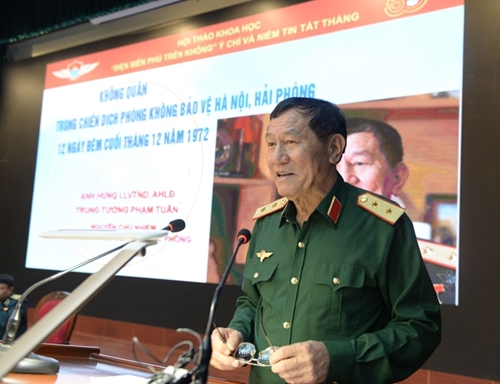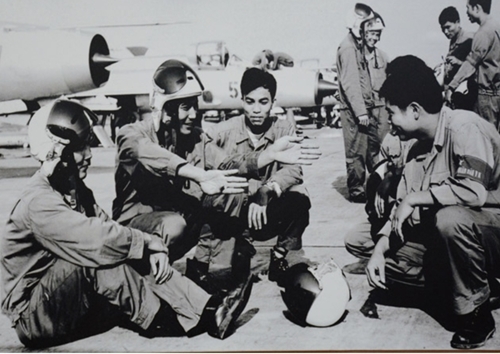The Vietnamese air force had raised these concerns and was well-prepared in order to combat the B-52 Stratofortress during the Hanoi - Hai Phong Air Defense Campaign in December 1972. One of the pilots who contributed to the extraordinary victory was Hero of the People’s Armed Forces Lieutenant General Pham Tuan.
An unequal battle
How did Vietnamese pilots use MiG-21s to destroy B-52s escorted by many tactical aircraft?
Before answering the question, Lieutenant General Pham Tuan underscored the power of the U.S. Air Force at that time. During Operation Linebacker II, the U.S. sent 193 B-52s. Each bomber was equipped with dozens of jamming devices and 20mm guns to counter MiG-21s.
    |
 |
|
Hero of the People’s Armed Forces Lieutenant General Pham Tuan |
In addition, the enemy also took advantage of nearly 1,000 tactical aircraft modified with jamming devices. Among them, the F-111A ground attack aircraft was able to fly at low attitudes and bring up to 10 tons of bombs. Other modern jamming jets were EB-66, EA-6B, and EC-121. Additionally, the U.S. jammed the whole operation area with a strong force, cutting-edge weapons and equipment. At the same time, the enemy also gave priority to attacking airports and then deployed fighters to prevent Vietnamese MiG-21s from approaching B-52s.
Meanwhile, the Vietnamese air force only had five regiments, including four Fighter Regiments 921, 927, 923, and 925, and Transport Regiment 919. Particularly, there were only 10 pilots on duty at night, and more than half of them had never been to narrow field airports or complicated terrain before.
To prepare for the campaign, the Air Defense - Air Force (ADAF) Service rebuilt two field airports in Thi Xuan and Cam Thuy (Thanh Hoa province), while Kep Airfield in Bac Giang province was also upgraded to meet the requirements of MiG-21 night takeoff and landing. Besides, the ADAF Service Command requested its troops to try to destroy B-52s early and from afar at night before they could approach targets, and work with other forces to protect missile battlefields.
The operation plan required pilots to be skilled, brave, and clever, as well as ensure the secret factor when approaching B-52s at night. Therefore, air force units made thorough preparations for the campaign.
The service also deployed pilots to the Central Region to coordinate with functional units to support the frontline while training their takeoff and landing’s capabilities on short and narrow runways. Especially, in August 1971, in Quang Binh, the Air Force Corps and the Radar Corps worked together to study and support the air force to attack B-52s from Northern Road 9 to Mu Gia Pass. The service also increased the number of radar stations from Do Luong (Nghe An province) to Vinh Linh (Quang Tri province) to detect B-52s from afar.
As a result, pilot Dinh Ton (on October 4, 1971) and Vu Dinh Rang (on November 20, 1971) approached B-52 formations. Pilot Vu Dinh Rang fired a missile that struck a B-52. These dogfights brought them a lot of experience on how to fight B-52s during the coming Hanoi - Hai Phong Air Defense Campaign in December 1972.
Air force makes victory
“On December 18, 1972, the air force moved to their designated positions at Da Phuc, Kep, and Hoa Lac airfields. At 19:47, I was ordered to take off from Da Phuc Airfield, turned around at a low altitude, headed to Hoa Binh, and went up to an altitude of about 4km when I detected many signal lights of F-4s. After passing the F-4 formation, I turned right to the west, and approached the B-52 formation. At an altitude of more than 6km, detecting the lights of the B-52, I turned on the booster, opened the search radar. At that moment, I was detected and followed by several F-4s, the B-52 lights then turned off, my radar screen was jammed. I tried to avoid F-4s and was requested to fly back to Da Phuc Airport for landing,” said Lieutenant General Pham Tuan.
Despite the enemy’s fierce raids, the Vietnamese air force bravely approached B-52s to disrupt the enemy’s formation, creating conditions for rockets and anti-aircraft artillery troops to hit these targets. The Vietnamese air force kept taking off in small groups, single aircraft, almost every night in heavy jamming situations and among enemy’s fighters. Many pilots such as Dinh Ton, Vu Xuan Thieu, Vu Dinh Rang, Tran Cung, Bui Doan Do... detected B-52 lights but had no chance to attack.
According to Lieutenant General Pham Tuan, the enemy tried their best to stop our forces both on the ground and in the air. Even though knowing the directions of the U.S. B-52s, the Vietnamese air force also faced difficulties in deploying aircraft at field airports and could not destroy the enemy from afar.
    |
 |
|
A detachment of MiG-21 meeting after shooting down an F-4 on December 27, 1972 |
As the missile force continuously recorded achievements, leaders of the Defense Ministry and ADAF Service were eager to see the air force shooting down B-52s. Learning about the first stage of the campaign, on December 25, in a joint conference between air force and radar units, the ADAF Service Command decided to deploy fighters to other airfields like Yen Bai, Cam Thuy and Tho Xuan, which were located far from the above mentioned airfields, and kept secret when they were flying. At the same time, the service mobilized a radar company from Hanoi to Thanh Hoa province and reinforced a radar company in Moc Chau (Son La province) to form a two-layer guiding radar network. Our radars would facilitate pilots to choose the best plans to approach B-52.
Thanks to the new turning-point guidance, our air force finally achieved feats-of-arms. Especially, at nights of December 27 and 28, pilots Pham Tuan and Vu Xuan Thieu successfully downed two B-52s, contributing to trouncing the U.S. raid by the bombers to Hanoi and several Northern localities. Right on the night of December 27, General Vo Nguyen Giap, Commander-in-Chief of the Vietnam People’s Army, sent a telegram to commend the air force’s feats-of-arms.
Translated by Minh Anh